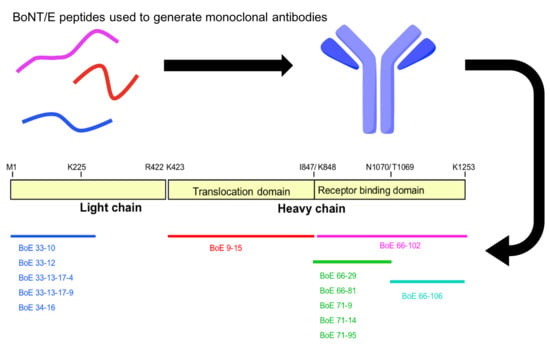Development and Characterization of Monoclonal Antibodies to Botulinum Neurotoxin Type E
Abstract
:1. Introduction
2. Results
2.1. Isolation and Characterization of Monoclonal Antibodies
2.2. Antibody Specificity
2.3. Binding Epitopes
2.4. Capture ELISA
2.5. Matrix Study
3. Discussion
4. Materials and Methods
4.1. Reagents
4.2. Recombinant BoNT/E3-GST Fusion Proteins
4.3. Monoclonal Antibody Procedure
4.4. Screening Methods
4.4.1. Directing Binding ELISA
4.4.2. Capture-Capture ELISA
4.5. Antibody Isotyping, Western Blotting, Peptide Binding
4.6. Binding of Antibodies to BoNT Serotypes A Through G
4.7. Sandwich Assay Procedure
4.8. Preparation of Spiked Food Matrices
Supplementary Materials
Author Contributions
Funding
Acknowledgments
Conflicts of Interest
References
- Peck, M.W.; Smith, T.J.; Anniballi, F.; Austin, J.W.; Bano, L.; Bradshaw, M.; Cuervo, P.; Cheng, L.W.; Derman, Y.; Dorner, B.G.; et al. Historical perspectives and guidelines for botulinum neurotoxin subtype nomenclature. Toxins 2017, 9, 38. [Google Scholar] [CrossRef] [PubMed]
- Zhang, S.; Masuyer, G.; Zhang, J.; Shen, Y.; Lundin, D.; Henriksson, L.; Miyashita, S.I.; Martinez-Carranza, M.; Dong, M.; Stenmark, P. Identification and characterization of a novel botulinum neurotoxin. Nat. Commun. 2017, 8, 14130. [Google Scholar] [CrossRef] [PubMed]
- CDC. Botulism Annual Summary, 2016; US Department of Health and Human Services: Atlanta, Georgia, 2017. Available online: https://www.cdc.gov/botulism/pdf/Botulism-2016-SUMMARY-508.pdf (accessed on 1 April 2019).
- Carter, A.T.; Peck, M.W. Genomes, neurotoxins and biology of Clostridium botulinum group I and group II. Res. Microbiol. 2015, 166, 303–317. [Google Scholar] [CrossRef] [PubMed]
- Hyytia, E.; Hielm, S.; Korkeala, H. Prevalence of Clostridium botulinum type E in finnish fish and fishery products. Epidemiol. Infect. 1998, 120, 245–250. [Google Scholar] [CrossRef]
- Leclair, D.; Farber, J.M.; Pagotto, F.; Suppa, S.; Doidge, B.; Austin, J.W. Tracking sources of c Clostridium botulinum type E contamination in seal meat. Int. J. Circumpol. Heal. 2017, 76, 1380994. [Google Scholar] [CrossRef]
- Chipault, J.G.; White, C.L.; Blehert, D.S.; Jennings, S.K.; Strom, S.M. Avian botulism type E in waterbirds of Lake Michigan, 2010–2013. J. Great Lakes Res. 2015, 41, 659–664. [Google Scholar] [CrossRef]
- Botulism in Alaska—November 2017; Alaska Division of Public Health, 2017; p. 34. Available online: http://dhss.alaska.gov/dph/Epi/id/siteassets/Pages/botulism/monograph.pdf (accessed on 1 April 2019).
- Miller, L.G. Observations on the distribution and ecology of Clostridium botulinum type E in Alaska. Can. J. Microbiol. 1975, 21, 920–926. [Google Scholar] [CrossRef] [PubMed]
- McLaughlin, J.B.; Sobel, J.; Lynn, T.; Funk, E.; Middaugh, J.P. Botulism type E outbreak associated with eating a beached whale, Alaska. Emerg. Infect. Dis. 2004, 10, 1685–1687. [Google Scholar] [CrossRef]
- Sobel, J.; Tucker, N.; Sulka, A.; McLaughlin, J.; Maslanka, S. Foodborne botulism in the United States, 1990–2000. Emerg. Infect. Dis. 2004, 10, 1606–1611. [Google Scholar] [CrossRef]
- Notermans, S.; Dufrenne, J.; Kozaki, S. Enzyme-linked immunosorbent assay for detection of Clostridium botulinum type E toxin. Appl. Environ. Microbiol. 1979, 37, 1173–1175. [Google Scholar] [CrossRef]
- Cadieux, B.; Blanchfield, B.; Smith, J.P.; Austin, J.W. A rapid chemiluminescent slot blot immunoassay for the detection and quantification of Clostridium botulinum neurotoxin type E. Int. J. Food Microbiol. 2005, 101, 9–16. [Google Scholar] [CrossRef] [PubMed]
- Poli, M.A.; Rivera, V.R.; Neal, D. Development of sensitive colorimetric capture ELISAs for Clostridium botulinum neurotoxin serotypes E and F. Toxicon 2002, 40, 797–802. [Google Scholar] [CrossRef]
- Abbasova, S.G.; Rudenko, N.V.; Gorokhovatskii, A.Y.; Kapralova, M.V.; Vinogradova, I.D.; Vertiev, Y.V.; Nesmeyanov, V.A.; Grishin, E.V. Monoclonal antibodies to botulinum neurotoxins of types A, B, E, and F. Russ. J. Bioorg. Chem. 2011, 37, 307–315. [Google Scholar] [CrossRef]
- Kamata, Y.; Kozaki, S.; Nagai, T.; Sakaguchi, G. Production of monoclonal-antibodies against Clostridium botulinum type E derivative toxin. FEMS Microbiol. Lett. 1985, 26, 305–309. [Google Scholar] [CrossRef]
- Tsuzuki, K.; Yokosawa, N.; Syuto, B.; Ohishi, I.; Fujii, N.; Kimura, K.; Oguma, K. Establishment of a monoclonal antibody recognizing an antigenic site common to c Clostridium botulinum type B, C1, D, and E toxins and tetanus toxin. Infect. Immun. 1988, 56, 898–902. [Google Scholar]
- Wong, P. Detection of Clostridium botulinum type E toxin by monoclonal antibody enzyme immunoassay. J. Rapid Methods Autom. Microbiol. 1996, 4, 191–206. [Google Scholar] [CrossRef]
- Garcia-Rodriguez, C.; Razai, A.; Geren, I.N.; Lou, J.; Conrad, F.; Wen, W.-H.; Farr-Jones, S.; Smith, T.J.; Brown, J.L.; Skerry, J.C.; et al. A three monoclonal antibody combination potently neutralizes multiple botulinum neurotoxin serotype E subtypes. Toxins 2018, 10, 105. [Google Scholar] [CrossRef]
- Bakherad, H.; Mousavi Gargari, S.L.M.; Rasooli, I.; Rajabibazl, M.; Mohammadi, M.; Ebrahimizadeh, W.; Safaee Ardakani, L.S.; Zare, H. In vivo neutralization of botulinum neurotoxins serotype E with heavy-chain camelid antibodies (VHH). Mol. Biotechnol. 2013, 55, 159–167. [Google Scholar] [CrossRef]
- Conway, J.O.; Sherwood, L.J.; Collazo, M.T.; Garza, J.A.; Hayhurst, A. Llama single domain antibodies specific for the 7 botulinum neurotoxin serotypes as heptaplex immunoreagents. PLoS ONE 2010, 5, e8818. [Google Scholar] [CrossRef]
- Cheng, L.W.; Land, K.M.; Stanker, L.H. Current methods for detecting the presence of botulinum neurotoxins in food and other biological samples. In Bioterrorism; Morse, S., Ed.; IntechOpen: Rijeka, Croatia, 2012; Chapter 1; pp. 1–16. [Google Scholar]
- Lindstrom, M.; Korkeala, H. Laboratory diagnostics of botulism. Clin. Microbiol. Rev. 2006, 19, 298–314. [Google Scholar] [CrossRef]
- Capek, P.; Dickerson, T.J. Sensing the deadliest toxin: Technologies for botulinum neurotoxin detection. Toxins 2010, 2, 24–53. [Google Scholar] [CrossRef] [PubMed]
- Shriver-Lake, L.C.; Zabetakis, D.; Goldman, E.R.; Anderson, G.P. Evaluation of anti-botulinum neurotoxin single domain antibodies with additional optimization for improved production and stability. Toxicon 2017, 135, 51–58. [Google Scholar] [CrossRef] [PubMed]
- Kozaki, S.; Kamata, Y.; Nagai, T.; Ogasawara, J.; Sakaguchi, G. The use of monoclonal-antibodies to analyze the structure of Clostridium botulinum type E derivative toxin. Infect. Immun. 1986, 52, 786–791. [Google Scholar] [PubMed]
- Fischer, A.; Garcia-Rodriguez, C.; Geren, I.; Lou, J.L.; Marks, J.D.; Nakagawa, T.; Montal, M. Molecular architecture of botulinum neurotoxin E revealed by single particle electron microscopy. J. Biol. Chem. 2008, 283, 3997–4003. [Google Scholar] [CrossRef] [PubMed]
- Kubota, T.; Watanabe, T.; Yokosawa, N.; Tsuzuki, K.; Indoh, T.; Moriishi, K.; Sanda, K.; Maki, Y.; Inoue, K.; Fujii, N. Epitope regions in the heavy chain of Clostridium botulinum type E neurotoxin recognized by monoclonal antibodies. Appl. Environ. Microbiol. 1997, 63, 1214–1218. [Google Scholar] [PubMed]
- Scotcher, M.C.; Cheng, L.W.; Stanker, L.H. Detection of botulinum neurotoxin serotype B at sub mouse LD50 levels by a sandwich immunoassay and its application to toxin detection in milk. PLoS ONE 2010, 5, e11047. [Google Scholar] [CrossRef] [PubMed]
- Scotcher, M.C.; Johnson, E.A.; Stanker, L.H. Characterization of the epitope region of f1-2 and f1-5, two monoclonal antibodies to botulinum neurotoxin type A. Hybridoma 2009, 28, 315–325. [Google Scholar] [CrossRef] [PubMed]
- Jenko, K.L.; Zhang, Y.; Kostenko, Y.; Fan, Y.; Garcia-Rodriguez, C.; Lou, J.; Marks, J.D.; Varnum, S.M. Development of an ELISA microarray assay for the sensitive and simultaneous detection of ten biodefense toxins. Analyst 2014, 139, 5093–5102. [Google Scholar] [CrossRef]
- Rivera, V.R.; Gamez, F.J.; Keener, W.K.; White, J.A.; Poli, M.A. Rapid detection of Clostridium botulinum toxins A, B, E, and F in clinical samples, selected food matrices, and buffer using paramagnetic bead-based electrochemiluminescence detection. Anal. Biochem. 2006, 353, 248–256. [Google Scholar] [CrossRef]
- Sharma, S.K.; Ferreira, J.L.; Eblen, B.S.; Whiting, R.C. Detection of type A, B, E, and F Clostridium botulinum neurotoxins in foods by using an amplified enzyme-linked immunosorbent assay with digoxigenin-labeled antibodies. Appl. Environ. Microb. 2006, 72, 1231–1238. [Google Scholar] [CrossRef]
- Singh, A.; Datta, S.; Sachdeva, A.; Maslanka, S.; Dykes, J.; Skinner, G.; Burr, D.; Whiting, R.C.; Sharma, S.K. Evaluation of an enzyme-linked immunosorbent assay (ELISA) kit for the detection of botulinum neurotoxins A, B, E, and F in selected food matrices. Health Secur. 2015, 13, 37–44. [Google Scholar] [CrossRef] [PubMed]
- Arnon, S.S.; Schechter, R.; Inglesby, T.V.; Henderson, D.A.; Bartlett, J.G.; Ascher, M.S.; Eitzen, E.; Fine, A.D.; Hauer, J.; Layton, M.; et al. Botulinum toxin as a biological weapon - medical and public health management. JAMA 2001, 285, 1059–1070. [Google Scholar] [CrossRef] [PubMed]
- Stanker, L.H.; Merrill, P.; Scotcher, M.C.; Cheng, L.W. Development and partial characterization of high-affinity monoclonal antibodies for botulinum toxin type A and their use in analysis of milk by sandwich ELISA. J. Immunol. Methods 2008, 336, 1–8. [Google Scholar] [CrossRef] [PubMed]
- Stanker, L.H.; Hnasko, R.M. A double-sandwich ELISA for identification of monoclonal antibodies suitable for sandwich immunoassays. Methods Mol. Biol. 2015, 1318, 69–78. [Google Scholar] [PubMed]
- Stanker, L.H.; Serban, A.V.; Cleveland, E.; Hnasko, R.; Lemus, A.; Safar, J.; DeArmond, S.J.; Prusiner, S.B. Conformation-dependent high-affinity monoclonal antibodies to prion proteins. J. Immunol. 2010, 185, 729–737. [Google Scholar] [CrossRef] [PubMed]
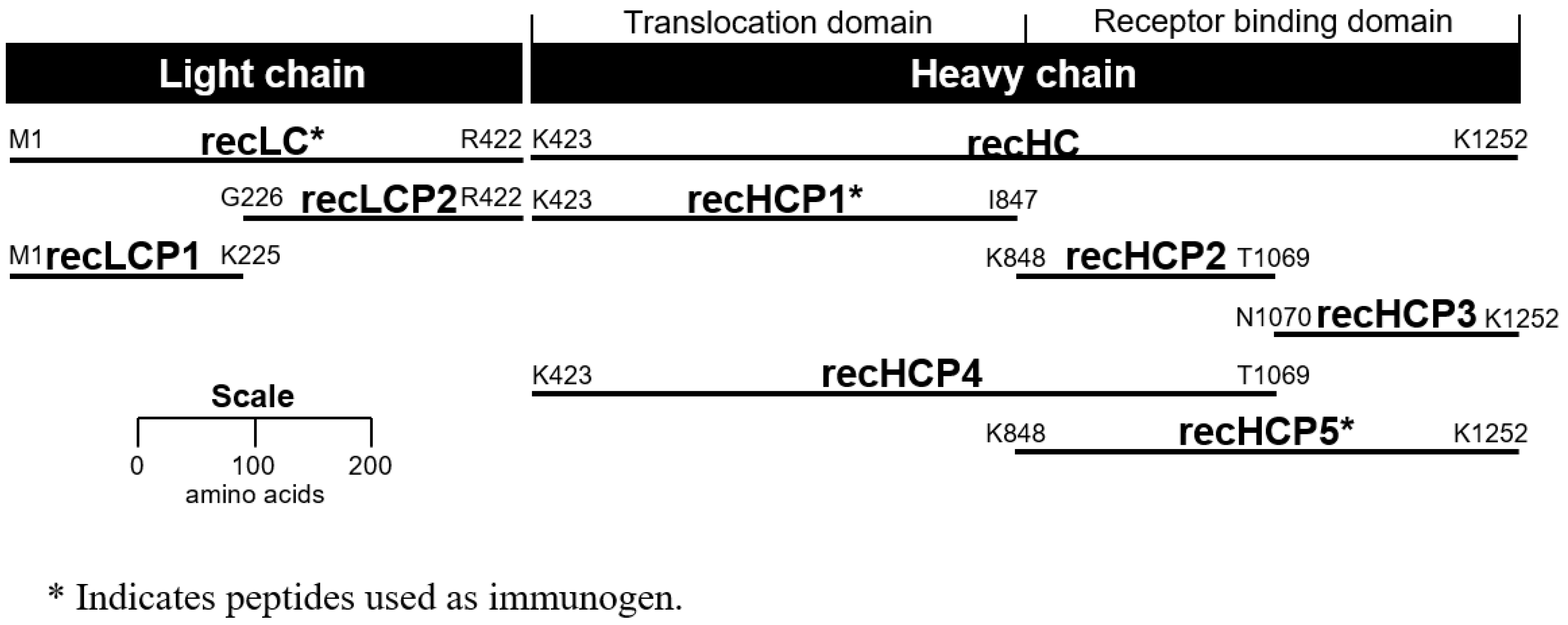
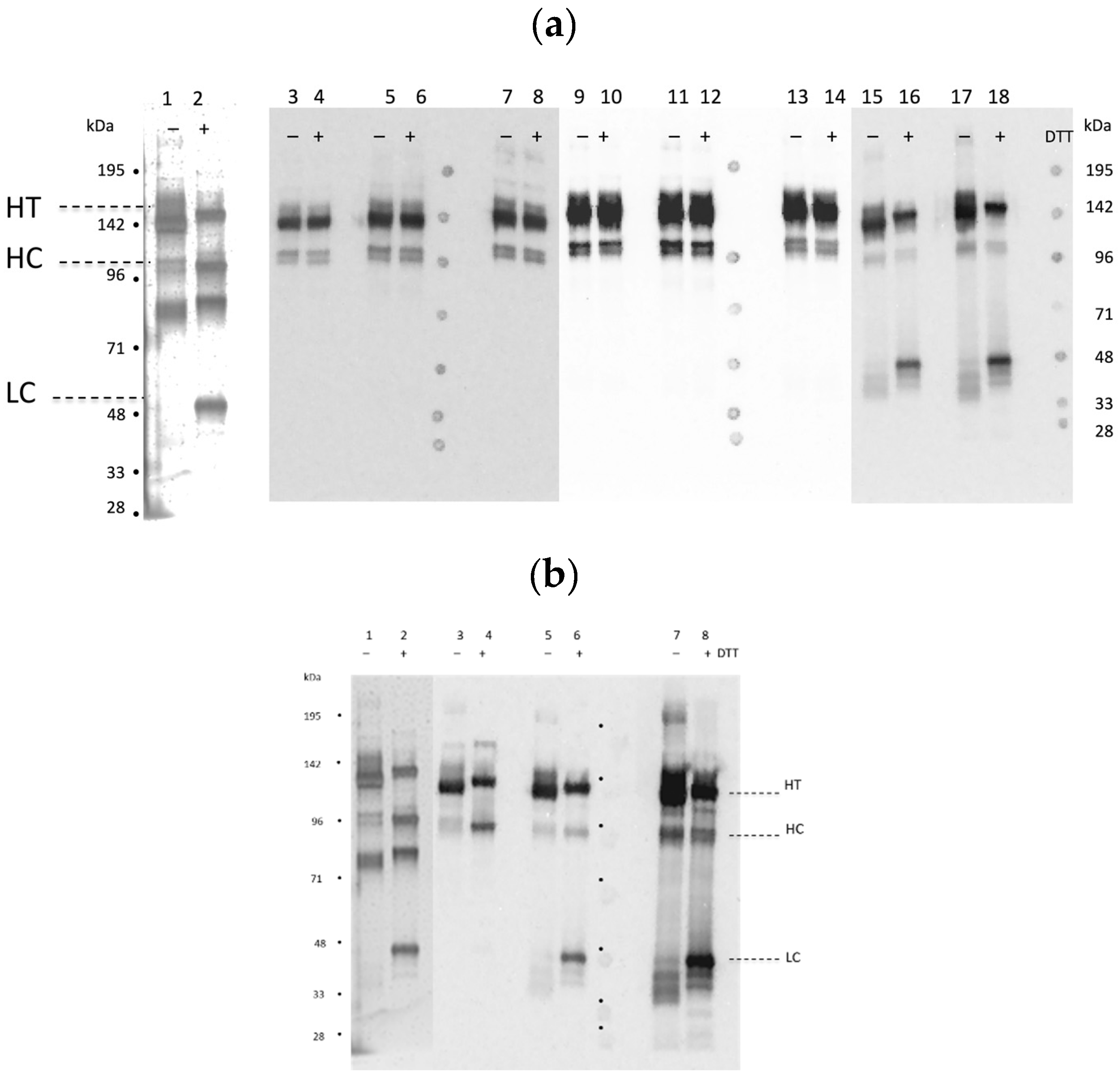
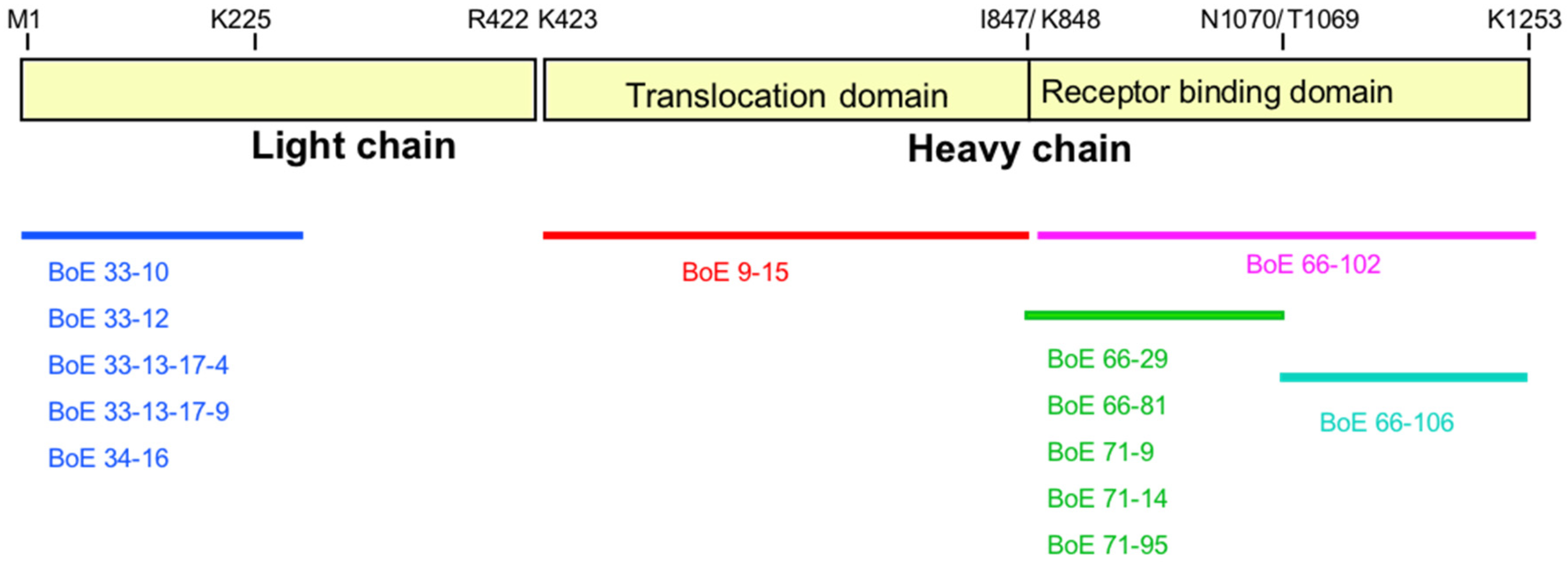
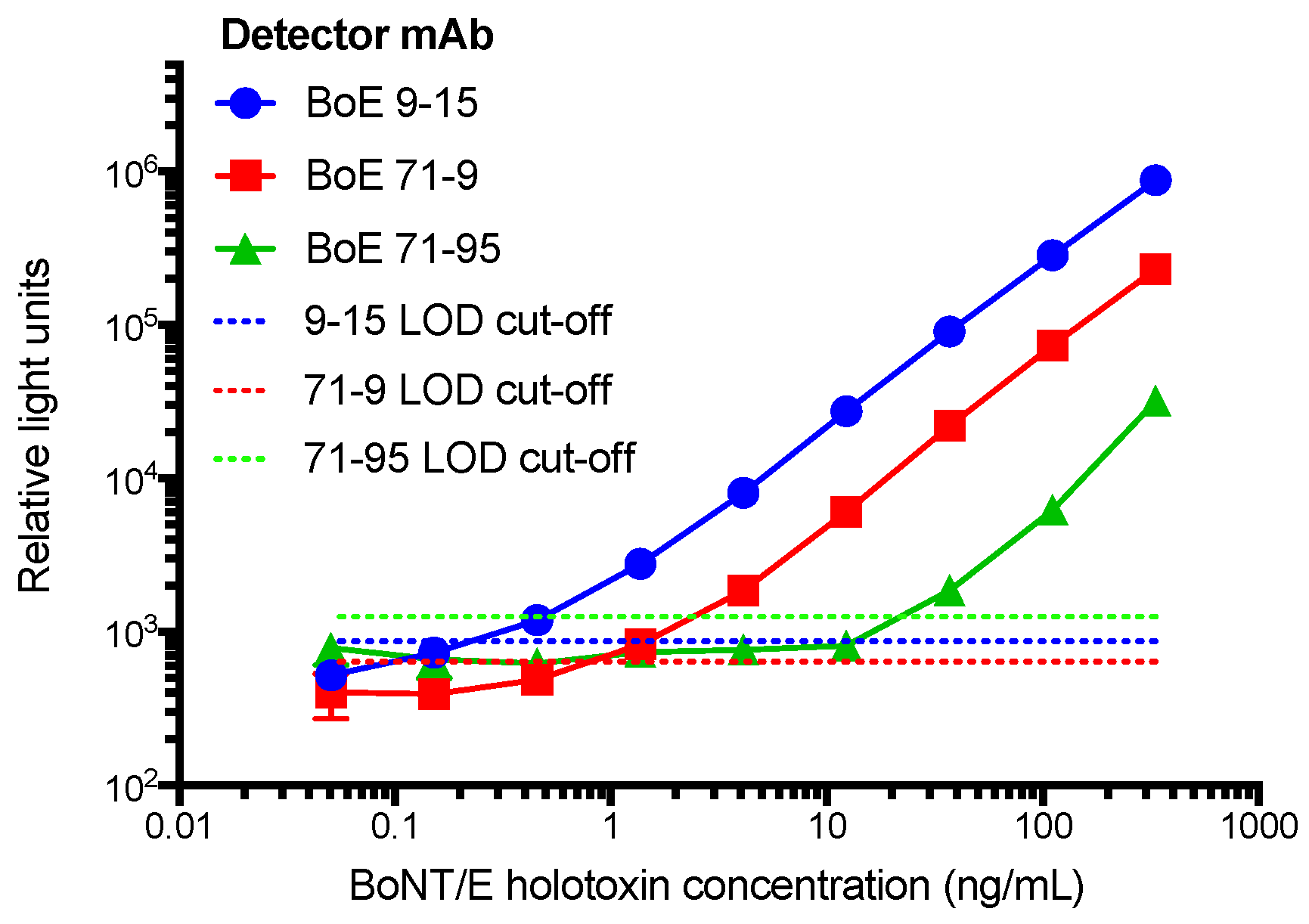
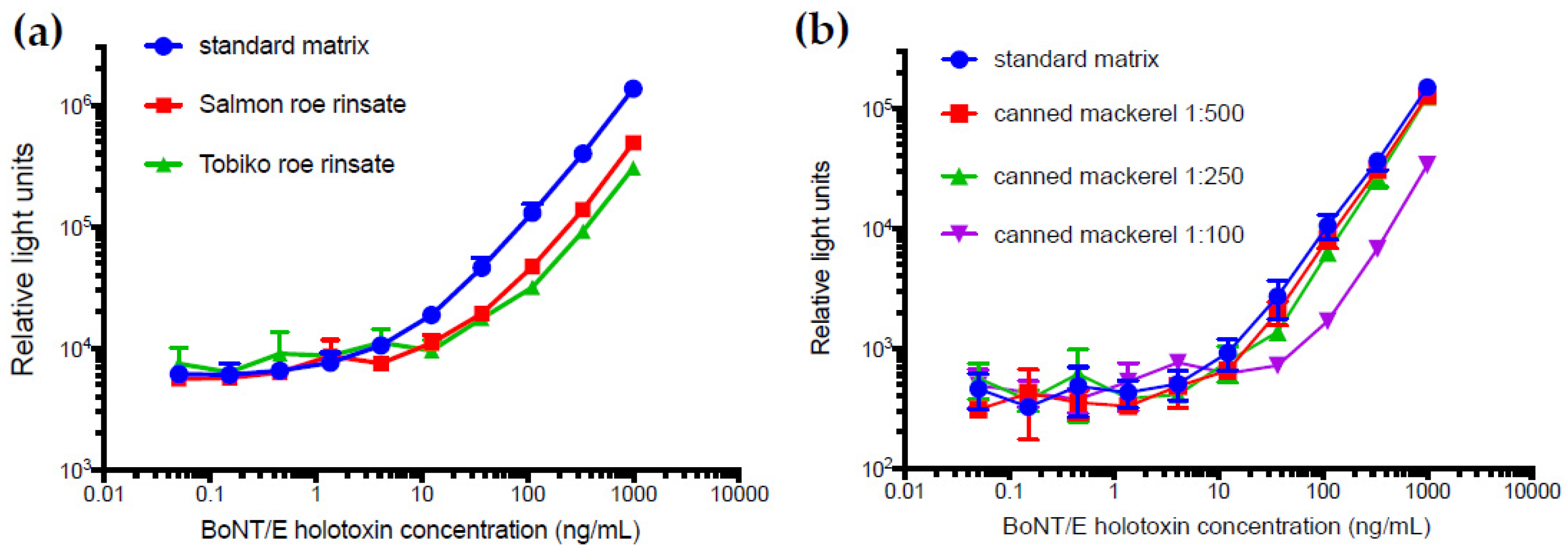
| Antibody | Immunogen 1 | Myeloma Fusion Partner | Fusion Screen | Isotype 2 | Peptides Bound 1 | Binding Domain | Serotype Specificity 3 |
|---|---|---|---|---|---|---|---|
| BoE 33-10 | recBoNT/E-LC | Sp2/0 | Direct binding | IgG2b | LC, LCP1 | M1–K225 | E, F > B > C, D, G |
| BoE 33-12 | recBoNT/E-LC | Sp2/0 | Direct binding | IgG1 | LC, LCP1 | M1–K225 | E, F > B > C, D, G, A |
| BoE 33-13-17-9 | recBoNT/E-LC | Sp2/0 | Direct binding | IgG1 | LC, LCP1 | M1–K225 | E, F > B > C, D, G |
| BoE 33-13-17-4 | recBoNT/E-LC | Sp2/0 | Direct binding | IgG1 | LC, LCP1 | M1–K225 | E >> B |
| BoE 34-16 | recBoNT/E-LC | Sp2/0 | Direct binding | IgG2a | LC, LCP1 | M1–K225 | E, F > B > C, D, G |
| BoE 9-15 | recBoNT/E-HCP1 | Sp2/0 | Capture/Capture | IgG2b | HC, HCP1, HCP4 | K423– I847 | E |
| BoE 66-29 | recBoNT/E-HCP5 | P3XU.1 | Capture/Capture | IgG1 | HC, HCP2, HCP4, HCP5 | K848–T1069 | E |
| BoE 66-81 | recBoNT/E-HCP5 | P3XU.1 | Capture/Capture | IgG2b | HC, HCP2, HCP4, HCP5 | K848–T1069 | E |
| BoE 66-106 | recBoNT/E-HCP5 | P3XU.1 | Capture/Capture | IgG1 | HC, HCP3, HCP5 | N1070– K1253 | E >> B |
| BoE 71-9 | recBoNT/E-HCP5 | Sp2/0 | Capture/Capture | IgG1 | HC, HCP2, HCP4, HCP5 | K848–T1069 | E (weak) |
| BoE 71-14 | recBoNT/E-HCP5 | Sp2/0 | Capture/Capture | IgG1 | HC, HCP2, HCP4, HCP5 | K848–T1069 | E |
| BoE 71-95 | recBoNT/E-HCP5 | Sp2/0 | Capture/Capture | IgG1 | HC, HCP2, HCP4, HCP5 | K848–T1069 | E |
| mAb | recLC | recLCP1 | recLCP2 | recHC | HCP1 | HCP2 | HCP3 | HCP4 | HCP5 |
|---|---|---|---|---|---|---|---|---|---|
| BoE 33-10 | 1.71 ± 0.04 | 1.79 ± 0.03 | 0.07 ± 0.00 | 0.07 ± 0.01 | 0.07 ± 0.01 | 0.08 ± 0.01 | 0.07 ± 0.0 | 0.08 ± 0.01 | 0.07 ± 0.00 |
| BoE 33-12 | 2.06 ± 0.01 | 2.05 ± 0.03 | 0.06 + 0.00 | 0.06 + 0.00 | 0.06 ± 0.01 | 0.08 ± 0.02 | 0.05 ± 0.00 | 0.08 ± 0.04 | 0.05 ± 0.03 |
| BoE 33-13-17-4 | 1.05 ± 0.09 | 1.25 ± 0.08 | 0.13 ± 0.01 | 0.09 ± 0.01 | 0.08 ± 0.01 | 0.13 ± 0.02 | 0.16 ± 0.00 | 0.1 ± 0.01 | 0.13 ± 0.02 |
| BoE 34-16 | 2.44 ± 0.04 | 2.46 ± 0.03 | 0.88 ± 0.02 | 0.08 ± 0.01 | 0.07 + 0.01 | 0.09 ± 0.01 | 0.07 ± 0.00 | 0.08 ± 0.01 | 0.06 + 0.01 |
| BoE 9-15 | 0.11 ± 0.08 | 0.07 ± 0.01 | 0.06 ± 0.02 | 1.17 ± 0.02 | 1.37 ± 0.01 | 0.07 ± 0.17 | 0.06 ± 0.02 | 1.2 ± 0.01 | 0.05 + 0.01 |
| BoE 66-29 | 0.05 ± 0.00 | 0.05 ± 0.00 | 0.05 ± 0.01 | 0.59 ± 0.02 | 0.05 ± 0.01 | 0.78 ± 0.02 | 0.05 + 0.15 | 0.7 ± 0.02 | 0.70 ± 0.02 |
| BoE 66-81 | 0.06 ± 0.03 | 0.05 ± 0.00 | 0.05 ± 0.02 | 0.55 ± 0.00 | 0.05 ± 0.12 | 0.91 + 0.04 | 0.06 ± 0.03 | 0.78 ± 0.08 | 0.7 ± 0.003 |
| BoE 66-106 | 0.06 ± 0.01 | 0.06 ± 0.01 | 0.06 + 0.01 | 0.62 ± 0.02 | 0.06 ± 0.01 | 0.06 ± 0.01 | 0.78 ± 0.02 | 0.07 ± 0.01 | 0.76 ± 0.03 |
| BoE 71-9 | 0.06 ± 0.01 | 0.06 ± 0.01 | 0.06 ± 0.00 | 0.23 ± 0.01 | 0.05 ± 0.01 | 0.77 ± 0.06 | 0.06 ± 0.01 | 0.61 + 0.03 | 0.51 ± 0.02 |
| BoE 71-14 | 0.06 ± 0.01 | 0.01 ± 0.01 | 0.06 ± 0.01 | 0.55 ± 0.04 | 0.06 ± 0.01 | 0.89 ± 0.04 | 0.10 ± 0.01 | 0.78 ± 0.03 | 0.74 + 0.03 |
| BoE 71-95 | 0.06 ± 0.01 | 0.06 ± 0.00 | 0.05 + 0.00 | 0.32 ± 0.01 | 0.06 ± 0.01 | 0.87 ± 0.07 | 0.06 ± 0.01 | 0.50 + 0.03 | 0.83 ± 0.05 |
| Primer Name | Sequence |
|---|---|
| AlaskaLCF | TAGC GGA TCC ATG CCA AAA ATT AAT AGT TTT AAT TAT AAT |
| AlaskaLCF2 | TAGC GGA TCC GGG ATT ACT ACA ACT TGT ATT ATA |
| AlaskaLCR | TAGC CTC GAG TTA CCT TAT GCC TTT TAC AGA AAC AA |
| AlaskaLCR2 | TAGC CTC GAG TTA TTT AGC CCC ATA TAG TCC ATG T |
| AlaskaHCF | TAGC GGA TCC AAA TCA ATA TGT ATC GAA ATA AAT AAT |
| AlaskaHCF2 | TAGC GGA TCC AAA AGT AGT TCA GTT TTA AAT ATG AG |
| AlaskaHCF3 | TAGC GGA TCC AAT ATT TTG AAG GAT TTT TGG GGA |
| AlaskaHCR | TAGC CTC GAG TTA TTT TTC TTG CCA TCC ATG TT |
| AlaskaHCR1 | TAGC CTC GAG TTA AAT TCT CTT AAA GAA TTT ATT AAA ATA T |
| AlaskaHCR2 | TAGC CTC GAG TTA TGT ATT AGG TTC ATT GCT ATA TAA A |
© 2019 by the authors. Licensee MDPI, Basel, Switzerland. This article is an open access article distributed under the terms and conditions of the Creative Commons Attribution (CC BY) license (http://creativecommons.org/licenses/by/4.0/).
Share and Cite
Bever, C.S.; Scotcher, M.; Cheng, L.W.; Hnasko, R.M.; Stanker, L.H. Development and Characterization of Monoclonal Antibodies to Botulinum Neurotoxin Type E. Toxins 2019, 11, 407. https://0-doi-org.brum.beds.ac.uk/10.3390/toxins11070407
Bever CS, Scotcher M, Cheng LW, Hnasko RM, Stanker LH. Development and Characterization of Monoclonal Antibodies to Botulinum Neurotoxin Type E. Toxins. 2019; 11(7):407. https://0-doi-org.brum.beds.ac.uk/10.3390/toxins11070407
Chicago/Turabian StyleBever, Candace S., Miles Scotcher, Luisa W. Cheng, Robert M. Hnasko, and Larry H. Stanker. 2019. "Development and Characterization of Monoclonal Antibodies to Botulinum Neurotoxin Type E" Toxins 11, no. 7: 407. https://0-doi-org.brum.beds.ac.uk/10.3390/toxins11070407



